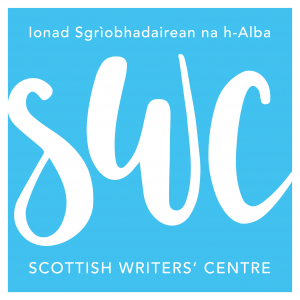Welcome to the first in an occasional series of writing tips, advice, and musings from a wonderful bunch of writers! As has been shown by the success in our events and blogs related to the writing process – everything from last year’s event ‘How to Get Published’ in association with Red Squirrel Press to blogs on the writer’s life – it is clear that the members, followers and readers of Scottish Writers’ Centre love reading about the act of putting words down on a page.
In this first post, Anne M Scriven writes – in beautiful prose – about her own process of life-writing. Back in February, I loved her event on ten women who have inspired and influenced her writing – you can check out the interview and blog post here – and when thinking of writers who could render the complexities and joys of writing, I immediately thought of Anne. I hope you enjoy her insightful and thoroughly enjoyable piece, and all the writing tips and essays we have to come! – Rachel
For the past fifteen minutes I have sat at my desk, fingers poised over keyboard, framing a first sentence. I decided on the one I have just written, and you have just read, because I think I should explain the question in my mind. I’m wondering, you see, if writing can actually be taught — yes, I know it’s a prevalent query and one that surely figures in every creative writing class — but I’ve never written out any of my thoughts on it, so I need to give attention to this question if I am in hope of moving on with this piece. Should we take cognisance, for example, of the wee Kirkcudbright centipede — the brilliant creation of singer-songwriter Matt McGinn — who learned that it was tricky, if not downright dangerous, to attempt an explanation of what she did most naturally? Should we be wary of a pedantic Jenny Longlegs, with pencil and pad, taking careful note of how we dance our best words?

Curiously, having acknowledged that thought which had kept its hand up till I did so, I find that it supplies a rule that I unconsciously but consistently follow when writing — i.e. the rule of noticing what my mind is doing. What it is presenting, what it is obstinately persisting with and will persist with until I release it in words. Right at the moment, my mind is giving me an image of this. It’s a swirling, eddying, cohesive mass of colour that rises like a cluster cloud of flocking starlings which suddenly dips and swoops, wheeling and twisting, then rises again but never quite in the same shape. It’s full of unstoppable energy which my mind now links to Einstein and his demonstration that energy cannot be destroyed but can only change its form. And I now see the tall form of my husband, Colum, saying this — he’s the sciency one in our partnership — and then immediately see me whispering it into the ear of my Aunt Clemmy as she lay on her bed in her convent home, in Surrey, where I said a final goodbye to her. My mind then takes me to the corner of the bookshop where I worked for six years and where we kept reference books and, for some reason, a particular edition that delineated Parkinson’s Law. It’s doing this I guess because although science is soooo not my field I do know there are agreed laws, and that if decent words are laid on them, I can understand them. So, do you see what I mean? The mind is a fantastic universal storehouse of material — which is continually expanding — that can instantaneously supply your thoughts and imagination and that area you look to — mine is up and to the right of my vision — when you are searching for the words you want.

The choice you then have is what to do with what you grab hold of. A fiction writer may decide to deliberately mix it all up a bit, change some facts, some detail or chronology, in the belief that this will throw the reader off the personal scent of the writer behind the text. This doesn’t quite happen of course. As Carol Shields, one of my literary gurus, states in the posthumous Startle and Illuminate (2016), that a fiction writer continually leaves clues about themselves in their writing — their education, geography, gender, intellect, bias, vision to name but some facets. The mask does not really hide the person wearing it. Life writers use the material a little differently. When my mind grasps hold of some luminous memory I pay attention to how it is staged. I ask myself questions — e.g : Are there colours in this memory or perhaps one dominant colour? Is it changing? Are there sounds? Is someone speaking? Where am I positioned in relation to what is happening? (N.B. Warning: this often has the knock-on effect in that when I recount a happening aloud to an audience I tend to wave my hands around as I am reliving how I see it in my mind. The audience can’t see what I am seeing, so confusion can occur.)
Memory, as Virginia Woolf noted so well in her essay ‘A Sketch of the Past’ (1939), does not work in a linear fashion. It is instead fragmentary and impressionistic. We ‘see’ snatches of colour, sound, movement etc which are arranged in our minds like the painting method of pointillism — dots of individual colour placed carefully and closely together to form an impression in the viewer’s eye. An impression is not total truth. It is just an impression. And that’s the other thing. Life writing is not truth. How can it be? It is a construction. A chosen set of words that describes a scene, a person, a place. Another writer who may have been present at the same event would choose other words. Much is left out. Writing, any writing, is therefore, as the literary theorist has it, just marks on a page, which are decoded by a reader. The reader brings their own understanding to those marks. An understanding based on individual influences.
So life writing is basically storytelling — that’s a good one to use if people get a bit jumpy about you drawing on shared experiences. But it helps me make sense of the world I experience and it also fosters a profound appreciation of life. At any moment, in any situation, there is always something going on if you just pause and pay attention. All is material. All is wondrous. All is amazing. A bit like the centipede’s dance which, if we prefer, we can just watch, applaud and leave the mechanics as mystery.

Words by Anne M Scriven
Anne M Scriven holds a PhD in Scottish Literature which she taught at university level for some years. An Honorary Fellow of the Centre for Scottish Cultural Studies, University of Strathclyde, Anne has a portfolio of published academic papers focusing for the main part on Margaret Oliphant and Scottish women writers. Her annotated edition of Oliphant’s novel Kirsteen, (1890), was the ASLS annual volume in 2010. Since leaving academia Anne has published three titles of narrative non-fiction: Learning to Listen: Life and a Nervous Dog (2013), Provenance : Tales from a Bookshop (2015) and Cadences: Notes from an Ordinary Life (2017). All titles are published by Kennedy & Boyd whom Anne previously worked with in a collaborative project that brought numerous titles of Scottish literature back into print. Anne currently runs a well-stocked bookstall in Glasgow’s famous Barras. See: www.ardgowanbooks.wordpress.com where members of SWC can on the production of their membership card, obtain 10% off the total cost of their purchases.



